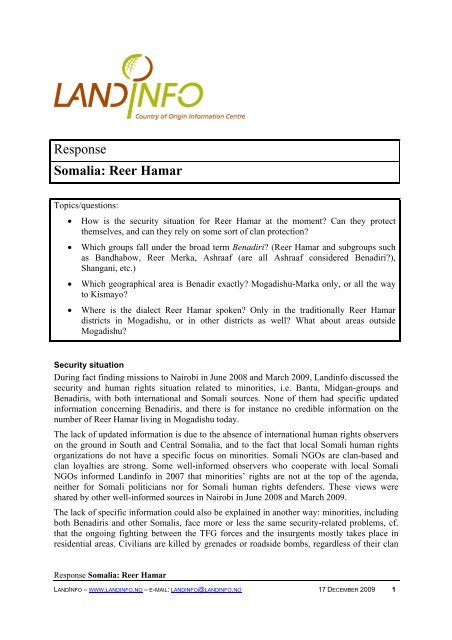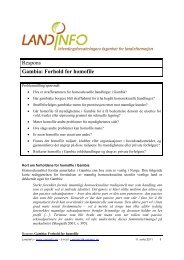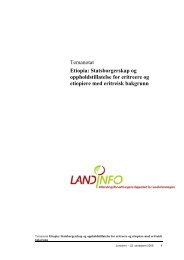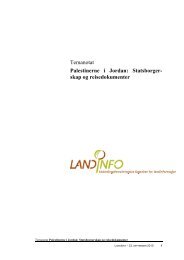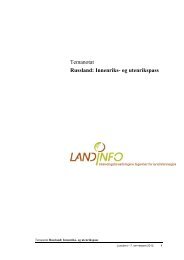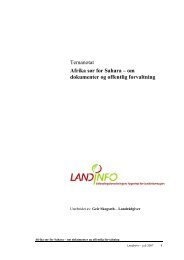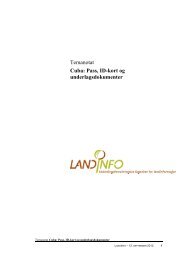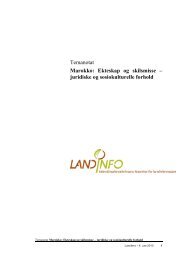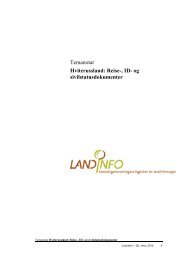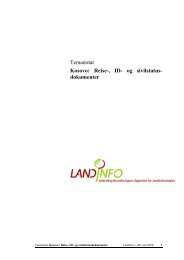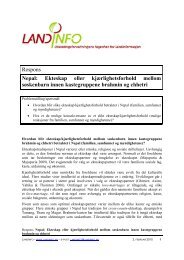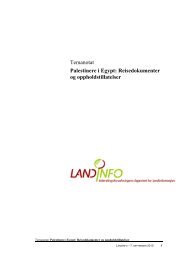Response Somalia: Reer Hamar - LandInfo
Response Somalia: Reer Hamar - LandInfo
Response Somalia: Reer Hamar - LandInfo
Create successful ePaper yourself
Turn your PDF publications into a flip-book with our unique Google optimized e-Paper software.
<strong>Response</strong><br />
<strong>Somalia</strong>: <strong>Reer</strong> <strong>Hamar</strong><br />
Topics/questions:<br />
• How is the security situation for <strong>Reer</strong> <strong>Hamar</strong> at the moment Can they protect<br />
themselves, and can they rely on some sort of clan protection<br />
• Which groups fall under the broad term Benadiri (<strong>Reer</strong> <strong>Hamar</strong> and subgroups such<br />
as Bandhabow, <strong>Reer</strong> Merka, Ashraaf (are all Ashraaf considered Benadiri),<br />
Shangani, etc.)<br />
• Which geographical area is Benadir exactly Mogadishu-Marka only, or all the way<br />
to Kismayo<br />
• Where is the dialect <strong>Reer</strong> <strong>Hamar</strong> spoken Only in the traditionally <strong>Reer</strong> <strong>Hamar</strong><br />
districts in Mogadishu, or in other districts as well What about areas outside<br />
Mogadishu<br />
Security situation<br />
During fact finding missions to Nairobi in June 2008 and March 2009, Landinfo discussed the<br />
security and human rights situation related to minorities, i.e. Bantu, Midgan-groups and<br />
Benadiris, with both international and Somali sources. None of them had specific updated<br />
information concerning Benadiris, and there is for instance no credible information on the<br />
number of <strong>Reer</strong> <strong>Hamar</strong> living in Mogadishu today.<br />
The lack of updated information is due to the absence of international human rights observers<br />
on the ground in South and Central <strong>Somalia</strong>, and to the fact that local Somali human rights<br />
organizations do not have a specific focus on minorities. Somali NGOs are clan-based and<br />
clan loyalties are strong. Some well-informed observers who cooperate with local Somali<br />
NGOs informed Landinfo in 2007 that minorities’ rights are not at the top of the agenda,<br />
neither for Somali politicians nor for Somali human rights defenders. These views were<br />
shared by other well-informed sources in Nairobi in June 2008 and March 2009.<br />
The lack of specific information could also be explained in another way: minorities, including<br />
both Benadiris and other Somalis, face more or less the same security-related problems, cf.<br />
that the ongoing fighting between the TFG forces and the insurgents mostly takes place in<br />
residential areas. Civilians are killed by grenades or roadside bombs, regardless of their clan<br />
<strong>Response</strong> <strong>Somalia</strong>: <strong>Reer</strong> <strong>Hamar</strong><br />
LANDINFO – WWW.LANDINFO.NO – E-MAIL: LANDINFO@LANDINFO.NO 17 DECEMBER 2009 1
ackground or ethnic affiliation. There is no information indicating that members of the <strong>Reer</strong><br />
<strong>Hamar</strong> community are being specifically targeted. Assassinations and politically motivated<br />
killings target journalists, TFG members and key personnel belonging to the police and<br />
security forces.<br />
Many members of the remaining <strong>Reer</strong> <strong>Hamar</strong> community have probably adapted to the<br />
shifting security environment through the past decade, either by buying protection from the<br />
various militias and local warlords that controlled the neighbourhoods of Mogadishu 1 or by<br />
marrying off their daughters to militia members; the so called black cat arrangement. These<br />
kind of arrangements were common until the Union of Islamic Courts took control of<br />
Mogadishu in 2006. 2 Then the situation for the inhabitants of Mogadishu, including the <strong>Reer</strong><br />
<strong>Hamar</strong> community, improved, mainly because crime was reduced (interviews in Nairobi,<br />
March 2007).<br />
Which groups do fall under the broad term Benadiri<br />
The term Benadiri has only been used about people since 1991. Before that it was strictly a<br />
geographical term referring to the southern Somali coast.<br />
According to Reese (2008), the Benadiris belong to a number of largely urban lineages from<br />
Mogadishu, Marka and Barawe (Brava). Some of these lineages claim foreign origins<br />
(Yemen, Persia, Spain, etc.), while the Moorshe for instance regard themselves as an offshot<br />
of the Ajuran, a pastoral group believed to have ruled the southern interior during the<br />
sixteenth and seventeenth centuries. According to current oral traditions, five of the eight<br />
Bandawow sub-lineages also have pastoral origins (Reese 2008). So the Benadiri do actually<br />
not constitute a clan at all – that is, they do not all claim to be descendants from the same<br />
ancestor. They are a group or category of clans, including sub-clans, of light skin (so called<br />
gibilcad in Somali), and of partly Arab descent. They are allied with and indentified with<br />
other sub-clans.<br />
According to different <strong>Reer</strong> <strong>Hamar</strong> sources (interviews in Nairobi 2002-2007, interviews in<br />
Oslo august 2005) there are four major <strong>Reer</strong> <strong>Hamar</strong> clans (Somali: afarta reer xamar). These<br />
are the Moorshe, Iskashato, DhabarWeyne and the Bandawow. In addition to these, there are<br />
many other smaller groups. Different sources mention different numbers of groups etc.,<br />
1 According to representatives from the Shansiye, “every door” paid 3 000 somali shilling in protection money<br />
on a daily basis (interview in Nairobi, September 2005).<br />
2 According to representatives from Shansiye interviewed by Landinfo in Nairobi in September 2005, the socalled<br />
dark-skinned Benadiris, i.e. Moorshe, Bandawow and Dhabarweyne, were protected by their Somali<br />
neighbours because they were dark-skinned (and presumed to be more native Somali), while most of the lightskinned<br />
Benadiris had fled at the beginning of the civil war (1991-1992). Furthermore, the majority of the darkskinned<br />
<strong>Reer</strong> <strong>Hamar</strong> stayed until the mid 1990s, when many of them left the country. These representatives<br />
claimed at the time that very few <strong>Reer</strong> <strong>Hamar</strong> still lived in Mogadishu, and a representative from the human<br />
rights organisation DIJHRO told Landinfo in September 2005 that members of the minority communities that<br />
used to live in Shangani had left during the civil war.<br />
Several both Somali and international sources Landinfo met with during the fact finding mission in 2005, as well<br />
as during later missions, stated that members of these groups were not targeted because of their ethnic origin.<br />
One well-informed Somali source stated in 2005 that one of the deputy mayors of Mogadishu at that time was<br />
<strong>Reer</strong> <strong>Hamar</strong>. Other sources have later explained that the so-called black cat arrangements are no longer a<br />
necessity since the previous oppressors no longer are in control in <strong>Hamar</strong> Weyne.<br />
<strong>Response</strong> <strong>Somalia</strong>: <strong>Reer</strong> <strong>Hamar</strong><br />
LANDINFO – WWW.LANDINFO.NO – E-MAIL: LANDINFO@LANDINFO.NO 17 DECEMBER 2009 2
implying that some groups might actually be subgroups of other groups. The Ashraf in Bay<br />
region, however, are not classified as Benadiris since they are part of the Rahanweyne clan<br />
(Ashraf Sarman), while the Ashraf of Mogadishu do belong to the <strong>Reer</strong> <strong>Hamar</strong>. According to<br />
representatives from <strong>Reer</strong> <strong>Hamar</strong> groups consulted by the joint British, Danish and Dutch<br />
fact-finding mission to Nairobi in 2000, the Ashraf are divided into the following groups:<br />
• Hussein: <strong>Reer</strong> Sharif Maqbuul, Sharif Ahmed, Sharif Ba-Alawi.<br />
• Hassan: Mohamed Sharif, Sharif Ali, Sharif Ahmed, Ashraf Sarman.<br />
According to another account, five major Ashraf lineages were found in <strong>Somalia</strong> at the end of<br />
the nineteenth century (Reese 1996). The Ahmad, Jamal al-Leyl and Bah Alawi, claiming<br />
descent from Husayn, formed the majority living in the coastal towns. The much smaller<br />
Umar and Abdullah lineages, progeny of Hasan, lived as farmers and herders in the interior.<br />
However, these lists must not be taken as definitive. There are other groups such as the Ashraf<br />
Hassan al-Ahdali of Marka (Virginia Luling, e-mail communication 20 October 2006).<br />
The Geledi and the Begedi could, according to the British anthropologist and researcher<br />
Virginia Luling, also be considered as Benadiris because they consist of subclans which are<br />
conventionally described as light-skinned (gibilcad), with members generally noticeably<br />
lighter in complexion than their neighbours. (This is a conventional classification, however,<br />
and not all the members of these subclans are equally light-skinned). These subgroups trace<br />
their descent to the Arabian peninsula (e-mail communication 25 April 2005). Not all Geledi<br />
are gibilcad – they include dark-skinned subclans as well. Dr Ahmed Sharif Abbas supports<br />
this, and has stated that the <strong>Reer</strong> <strong>Hamar</strong> community itself recognises the Geledi and the<br />
Begedi as Benadiri (interview, 16 March 2005). 3<br />
Some of the lineages in Mogadishu can also be found in Marka and Barawe, where these and<br />
other lineages are collectively known as <strong>Reer</strong> Marka and <strong>Reer</strong> Barawe.<br />
Which geographical area is Benadir exactly Mogadishu-Marka only, or all the way to<br />
Kismayo<br />
The Benadir region as the term is used today only includes Mogadishu and its surroundings,<br />
but traditionally the term referred to the Benadir coast which included Mogadishu, Marka and<br />
Barawe.<br />
3 There is some confusion among scholars as to whether the Geledi should be classified as Benadiri or belonging<br />
to the Digil clan-family. In fact, both are true. The Digil, which is one of the two big southern agricultural clanfamilies,<br />
consists of many federated small groups, rather than being strictly all of one descent like the clans of<br />
the northern/pastoral tradition, the Hawiye, Darod and Isaq clan-families. The other large southern clan-family is<br />
the Rahanweyn (Mirifle). They also have a mixed or federal structure (the Geledi are also sometimes classified<br />
as Rahanweyn). The essential point here is that in the northern/pastoral tradition a person cannot belong to two<br />
different clans, unless one of them is a subdivision of the other. The same individual cannot be both Darod and<br />
Hawiye. Among the Digil and Rahanweyn (Mirifle) on the other hand, it is, according to Lewis (1994) and other<br />
sources, perfectly possible to belong to two clans or clan-families at once, because a group from one has been<br />
adopted into the other or has federated with it. Many people in these southern clans have a dual identity in this<br />
way (e-mail V. Luling, 25 April 2005).<br />
<strong>Response</strong> <strong>Somalia</strong>: <strong>Reer</strong> <strong>Hamar</strong><br />
LANDINFO – WWW.LANDINFO.NO – E-MAIL: LANDINFO@LANDINFO.NO 17 DECEMBER 2009 3
Where is the dialect <strong>Reer</strong> <strong>Hamar</strong> spoken Only in the traditionally <strong>Reer</strong> <strong>Hamar</strong> districts<br />
in Mogadishu, or in other districts as well What about areas outside Mogadishu<br />
No linguistic work has been done in <strong>Somalia</strong> since the 1980s, and Marcello Lamberti’s study<br />
Die Somali-Dialekte (1986) is one of the very few existing comparative studies of the various<br />
Somali dialects. According to this study, as well as other Somali sources, including Dr<br />
Ahmed Sharif Abbas, leader of the United Somali Benadiir Council in London (interview in<br />
London, 16 March 2005), the <strong>Hamar</strong>-dialect is still spoken by <strong>Reer</strong> <strong>Hamar</strong> members in <strong>Hamar</strong><br />
Weyne. Dr Abbas also stated that <strong>Reer</strong> <strong>Hamar</strong> living outside <strong>Hamar</strong> Weyne, particularly the<br />
older generation, have kept their dialect. Dr Abbas, who (at the time) cooperated with British<br />
authorities in order to identify Benadiri asylum seekers, did, however, not exclude non-<strong>Hamar</strong><br />
speaking applicants from being <strong>Reer</strong> <strong>Hamar</strong> since obviously not all actually speak the dialect.<br />
Dr. Martin Orwin, lecturer in Somali and Amharic at University of London’s School of<br />
Oriental and African Studies (SOAS), has underlined (personal communication 16 November<br />
2006) another important aspect: Other Somalis growing up and living in the same<br />
neighbourhood as the <strong>Reer</strong> <strong>Hamar</strong> probably also know and speak the <strong>Hamar</strong> dialect.<br />
Moreover, in most countries speakers of one dialect or language naturally come into direct or<br />
indirect contact with those of neighbouring (or culturally) dominant languages or dialects<br />
through business and trade relations, daily life or intermarriages. Whatever the degree or<br />
nature of contact between neighbouring peoples, it is generally sufficient to lead to some kind<br />
of linguistic interinfluencing, affecting not only the ethnic Somalis living in the <strong>Reer</strong> <strong>Hamar</strong><br />
neighbourhood, but also the <strong>Reer</strong> <strong>Hamar</strong> within <strong>Hamar</strong> Weyne and in other parts of the city.<br />
A response consists of answers to specific questions presented to Landinfo by case workers<br />
within the Norwegian immigration authorities. <strong>Response</strong>s are not intended to provide<br />
exhaustive reviews of a topic or theme, but should answer the specific questions posed and<br />
include relevant background information.<br />
References<br />
Written sources<br />
• Danish Immigration Service (2000, December). Report on minority groups in<br />
<strong>Somalia</strong>. Copenhagen: Danish Immigration Service. Available from<br />
http://www.unhcr.org/refworld/docid/3ae6a5fa0.html [accessed 17 December 2009]<br />
• Lamberti, M. (1986). Die Somali-Dialekte. Hamburg: Helmut Buske Verlag.<br />
• Reese, S. (1996). Patricians of the Benadir. Unpublished thesis for the University of<br />
Pennsylvania.<br />
• Reese, S. (2008). Renewers of the age. Holy men and social discourse in colonial<br />
Benaadir. Leiden/Boston: Brill.<br />
Oral sources<br />
• Abbas, Ahmed Sharif. Leader of the United Somali Benadiir Council in London.<br />
Interview in London 16 March 2005.<br />
<strong>Response</strong> <strong>Somalia</strong>: <strong>Reer</strong> <strong>Hamar</strong><br />
LANDINFO – WWW.LANDINFO.NO – E-MAIL: LANDINFO@LANDINFO.NO 17 DECEMBER 2009 4
• International sources. Interviews in Nairobi, September 2005, March 2007, June 2008,<br />
March 2009.<br />
• Luling, Virginia. E-mail communications 25 April 2005 and 20 October 2006.<br />
• Orwin, Martin. Lecturer in Somali and Amharic, University of London’s School of<br />
Oriental and African Studies (SOAS). Personal communication 16 November 2006.<br />
• <strong>Reer</strong> <strong>Hamar</strong> source. Interview in Oslo, August 2005.<br />
• Somali sources. Interviews in Nairobi, September 2005, March 2007, June 2008,<br />
March 2009.<br />
© Landinfo 2009<br />
The material in this report is covered by copyright law. Any reproduction or publication of this report or<br />
any extract thereof other than as permitted by current Norwegian copyright law requires the explicit<br />
written consent of Landinfo.<br />
<strong>Response</strong> <strong>Somalia</strong>: <strong>Reer</strong> <strong>Hamar</strong><br />
LANDINFO – WWW.LANDINFO.NO – E-MAIL: LANDINFO@LANDINFO.NO 17 DECEMBER 2009 5


